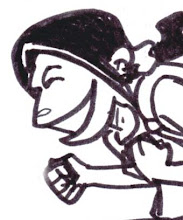
There is an inherent fragility in "House of Cards" - a simplicity which hints at deeper tones of beauty. A gorgeous, soothing ballad made up of humble parts, yet filled with apprehensive ideas. It is precisely this combination of romance and anxiety that director James Frost captures in his revolutionary new video for Radiohead's tune. It's a vision of humanity disintegrating into bits of digital information - albeit with grace and beauty.
Thom Yorke and company have continually been ahead of the industry curve when it comes to new technology, whether singing about it (
OK Computer), embodying it in sound (
Kid A) or utilizing it in new ways to market (
In Rainbows). Thematically they've tackled the unnerving and exciting collision between our creativity in industry and classical human self-expression. And with the video for "House of Cards" they (and Frost) present human feeling existing within the futuristic walls of our computers, yet existing on the very edges of extinction.

There is a story of lust, love and emotional detachment told through the 3D graphics on screen. It begins with the distorted image of the singer, as if emerging through television static, struggling to break free from the banality of his current state. In the lyrics of the song he asks for a lover, not a friend - inviting a girl at a suburban soirée to "throw your keys in the bowl" and swing over to his side. They are both tied to other people, but Yorke proposes flinging caution to the wind and diving into lust despite knowing that it will almost certainly end in disaster.
This is where the video soars. The images of not only the collapsing lovers, but of the falling world around them, invites the viewer to make larger connections between the small story in this apartment and the broader implications of the pictures. The singer wants us to forget the debility of life and emotion, but the fractured scenes make this impossible. What does it mean to be in "denial," as Yorke croons in the chorus? Are we kidding ourselves to believe true romance is possible; is trying to escape from the futility of loveless nights in itself
futile?
Furthermore, there is the suggestion that as we progress into and become one with our technological creations, we are losing something invaluable. The telephone lines which fade into darkness could mean that the things we invent to further enhance meaning, will actually give us nothing; disconnecting us from each other and leaving the world black, void of color. Perhaps, even in making this video, we risk losing part of the artistic hand in film making.
Yet, like the music, the despair is accompanied by serene hope. After all, Yorke's romantic suggestion, despite going against the better judgment of the lovers, is an avenue for escape from the sameness of that party - a momentary surge of energy. Maybe in denial, in letting our house crumble, we actually defeat inevitability. In a way Frost illuminates the world through his graphics, like an infrared lens finding the rainbows hidden in society. Even though we are bombarded with static fuzz, faces push through and make themselves visible - like Yorke's surprising, transcendent vocal melody rising above the repeating tune - we see the unrelenting spirit of human expression. Unclear, uncertain, but
alive.









